If you’re looking to infuse your outdoor space with a splash of tropical flair, “31 Tropical Garden Design” is here to help. This collection showcases a variety of vibrant ideas and creative designs, making it easy to transform your garden into a lush paradise. Dive in and discover how you can bring that inviting, warm feel of a tropical oasis right to your backyard!
Designing with Palm Trees as Focal Points

Palm trees can transform any garden into a tropical paradise. Their tall, graceful trunks and lush fronds draw the eye, creating a stunning focal point. Imagine walking through a garden where the sunlight filters through the palm leaves, casting playful shadows on the ground.
When planning your garden, think about the placement of palm trees. Position them strategically to create height and balance. Mixing different varieties can enhance the visual interest while keeping the theme cohesive. For instance, pairing tall palms with shorter, bushy plants can create an inviting space.
Adding colorful flowers or textured foliage around the base of palm trees can really make them pop. Consider low-growing plants that complement the palm’s vertical lines. This layering effect adds depth and makes the garden feel lush.
Don’t forget about maintenance! Regular care will keep your palm trees healthy and vibrant. Pruning any brown fronds and ensuring they have enough water can go a long way in maintaining their beauty.
Layering Plants for Depth and Texture

Creating a tropical garden is all about layering plants to add depth and texture. The image showcases a lush arrangement of various plants, each contributing its unique shape and color. Notice how the taller palm fronds create a backdrop, while the vibrant reds and greens in the foreground invite the eye in.
When selecting plants, consider their heights and leaf shapes. Group taller plants like palms or cycads at the back, allowing shorter, bushier plants to flourish in front. This technique not only enhances visibility but also mimics the natural layers found in tropical ecosystems.
Textural diversity matters too. For instance, the broad leaves of some plants contrast beautifully with the fine, spiky leaves of others. Mixing different textures can create an engaging visual experience. You can even add some flowering plants for pops of color that catch the light and draw attention.
Don’t forget about colors. The rich greens paired with deep reds and yellows in the image illustrate how different shades can complement each other. Experiment with various plant combinations to discover what looks best in your space.
Pathways That Invite Exploration

In a tropical garden design, pathways play a crucial role in guiding visitors through lush landscapes. The image showcases a beautifully crafted stone pathway winding through vibrant greenery. The stones vary in shape and size, creating a natural look that complements the surrounding plants.
The gentle curves of the pathway encourage exploration, drawing you further into the garden’s enchanting sights. Flanking the path, lush tropical plants add depth and texture, while pops of color from blooming flowers bring warmth and charm. The pathway invites you to wander and discover hidden gems within the garden.
Pathways like this not only enhance the garden’s aesthetic but also improve functionality. They create defined routes, making it easy to navigate through the foliage. When designing a tropical garden, consider how your pathways can lead visitors on a journey of discovery, showcasing both the beauty of the plants and the peaceful ambiance of the space.
Utilizing Water Features for Serenity
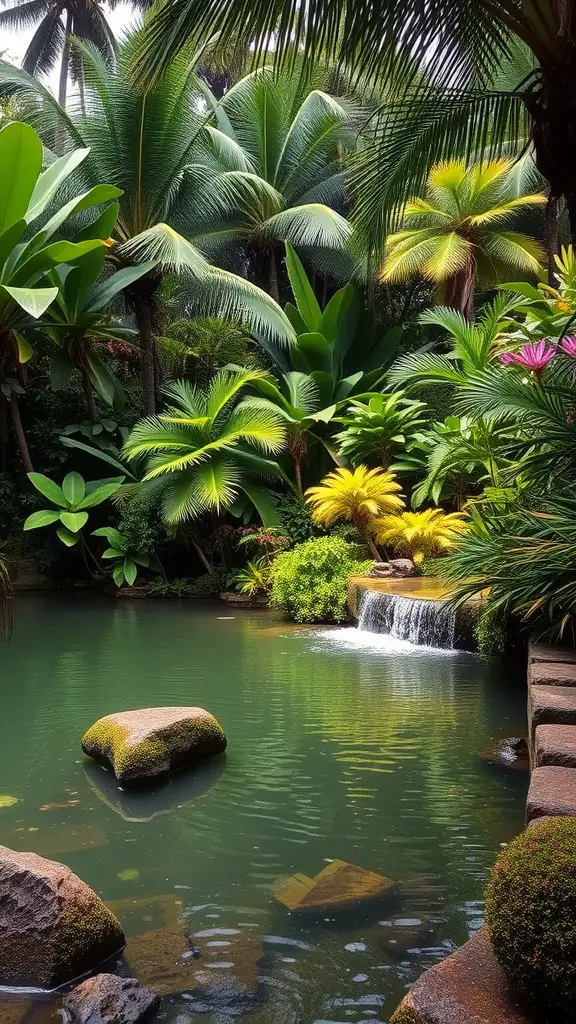
Water features can transform any tropical garden into a peaceful retreat. In the image, a tranquil pond reflects the lush greenery surrounding it. The gentle sound of a waterfall adds to the calming atmosphere, inviting you to unwind.
Incorporating a pond like this can enhance the natural beauty of your garden. Native plants, such as ferns and tropical flowers, beautifully frame the water, creating a harmonious blend of elements. Selecting the right plants is essential; they not only contribute to the scenery but also support local wildlife.
Consider adding smooth stones or boulders near the water’s edge. They provide resting spots for visitors and create a more natural look. The varied heights and textures help in adding depth to the design of your garden.
Overall, water features play a vital role in establishing a serene environment. They draw attention and encourage relaxation, making your tropical garden a place where you can escape and recharge.
Creating Outdoor Living Spaces

Designing outdoor living spaces can be a delightful process. The image illustrates a cozy nook surrounded by lush plants, making it an inviting spot. The choice of furniture, such as the wicker seating, adds a touch of warmth and comfort.
Incorporating tropical greenery not only enhances the aesthetic but also creates a serene atmosphere. The vibrant flowers and tall leaves provide both privacy and beauty, making it a perfect spot for relaxation.
Consider adding small tables and decorative items, like candles or vases, to personalize the space. This encourages gatherings, whether for morning coffee or evening chats with friends. Lighting, like the hanging lantern, can set a calming mood as the sun sets.
Lastly, think about the layout. Arrange seating to promote conversation and ensure easy movement. With the right touches, your outdoor area can transform into a welcoming retreat.
Creating Lush Foliage Canopies

Imagine stepping into a tropical paradise, surrounded by vibrant foliage that seems to reach for the sky. This image captures the essence of lush foliage canopies, where various types of leaves create a stunning overhead display. The interplay of light and shadow adds depth, making it feel like a serene escape.
When designing your own tropical garden, think about layering plants to create these canopies. Use tall palms and leafy tropical plants that provide height and structure. Position them strategically so they create a natural ceiling of greenery. This not only adds beauty but also offers shade, making your garden a comfortable retreat.
Diverse foliage is key. Incorporating a mix of plants with different shapes and colors will enhance the visual appeal. Consider plants like Monstera and large-leaved Philodendrons to contrast with slender palm fronds. The variety creates a rich tapestry that draws the eye and invites exploration.
Lastly, don’t forget to include pathways. They can meander through the greenery, inviting visitors to wander and discover hidden nooks. With careful planning, you can create a tropical oasis that feels alive and inviting, just like the scene depicted in the image.
Incorporating Tropical Flowers for Color

Tropical gardens are all about vibrant colors, and flowers are the stars of the show. Picture a scene filled with lively blooms like hibiscus and orchids. The bright reds, pinks, and yellows bring energy and joy to any space. These flowers not only look beautiful but also create a sense of paradise right in your backyard.
When you think about adding tropical flowers, consider mixing different varieties. For example, pairing bold hibiscus with delicate orchids creates a stunning contrast. This combination allows each flower to stand out while contributing to the overall lushness of the garden.
Don’t forget about the foliage! Large, green leaves can enhance the brightness of the flowers. They serve as a perfect backdrop, making those vibrant colors pop even more. Placing these flowers strategically can lead to eye-catching arrangements that draw everyone’s attention.
Incorporating tropical flowers is not just about aesthetics. These plants often attract butterflies and hummingbirds, adding even more life to your garden. The buzzing and fluttering around your flowers will make the garden feel warm and inviting, giving it a lively atmosphere.
Incorporating Edible Plants and Herbs
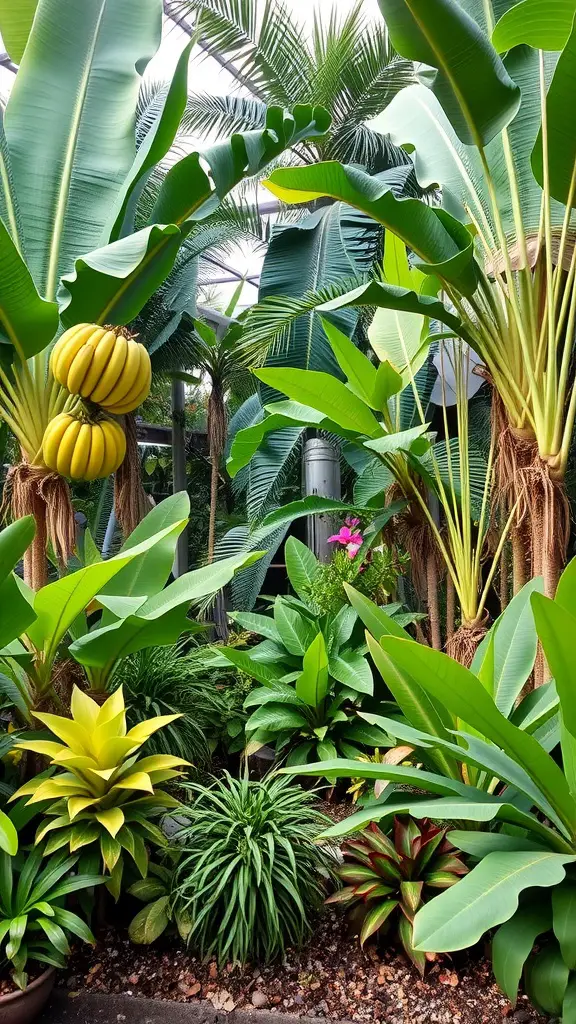
Designing a tropical garden offers a fun opportunity to blend aesthetics and functionality. Imagine lush greenery surrounding you, with vibrant plants adding color and life to your space. The image highlights a beautiful tropical garden with a variety of plants, including banana trees bearing bright yellow fruit, which perfectly represents the idea of incorporating edible plants.
Incorporating edible plants not only enhances your garden’s beauty but also provides delicious ingredients for your meals. Think of planting herbs like basil, mint, and cilantro alongside those tropical leaves. These herbs are easy to grow and can thrive in the same warm, sunny conditions that benefit tropical plants.
Consider adding some vegetables such as tomatoes or peppers. They can fit well into your garden layout and bring a fresh, homegrown taste to your dishes. Plus, planting edible varieties allows you to create a natural, sustainable food source right in your backyard.
Don’t forget about companion planting! Pairing herbs with other plants can help deter pests and promote healthy growth. For example, basil grows well near tomatoes, enhancing both flavors and keeping pests at bay.
As you plan, think about accessibility. You want to make sure that harvesting your herbs and fruits is easy. A little organization in your layout can make a big difference in your gardening experience.
Creating a tropical garden filled with edible plants and herbs is not just rewarding; it’s a delightful way to enjoy nature while providing for yourself. So grab your gardening gloves and start planning your vibrant, productive oasis!
Choosing the Right Soil for Tropical Plants
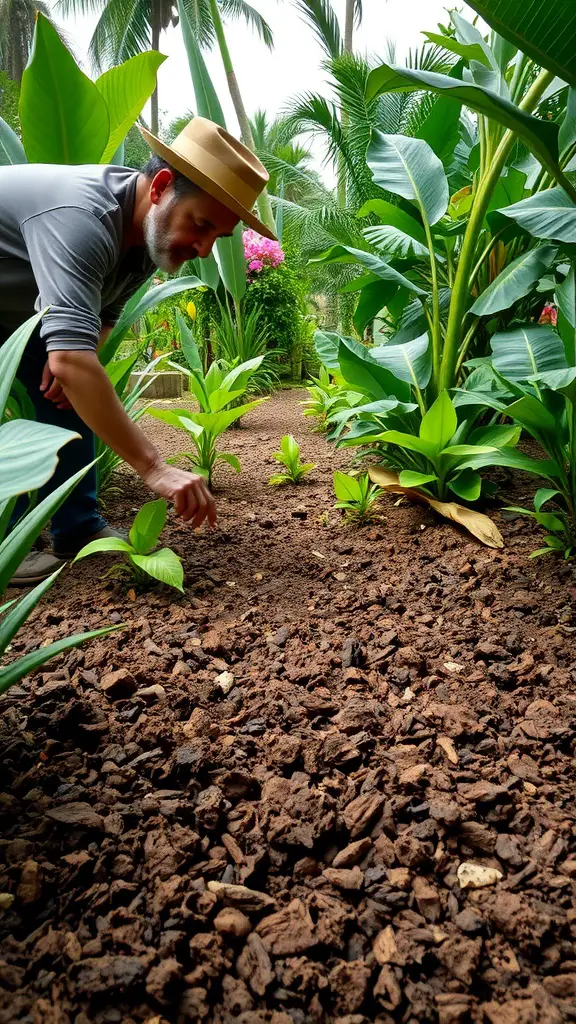
When designing a tropical garden, selecting the right soil is crucial for the success of your plants. The image showcases a gardener gently tending to the soil, surrounded by lush tropical foliage. This visual perfectly captures the essence of nurturing the earth beneath your plants, which is essential for their growth.
Tropical plants thrive in rich, well-draining soil that mimics their natural environment. This means incorporating organic matter like compost to enhance soil structure and fertility. As seen in the photo, the gardener is likely preparing to plant or care for young tropical plants, ensuring they have the optimal conditions to flourish.
Using soil that retains moisture without becoming waterlogged is key. A mix of peat, perlite, and coconut coir often works well for these types of gardens. This combination allows for good drainage while providing the necessary nutrients for healthy plant development.
As you plan your tropical garden, remember that soil quality directly impacts plant health. Just like the gardener in the image, take the time to care for your soil. Test its pH and nutrient levels to ensure it meets the needs of your tropical plants. With the right soil, your garden will thrive, bringing vibrant colors and life to your outdoor space.
Lighting Techniques to Enhance Nighttime Beauty
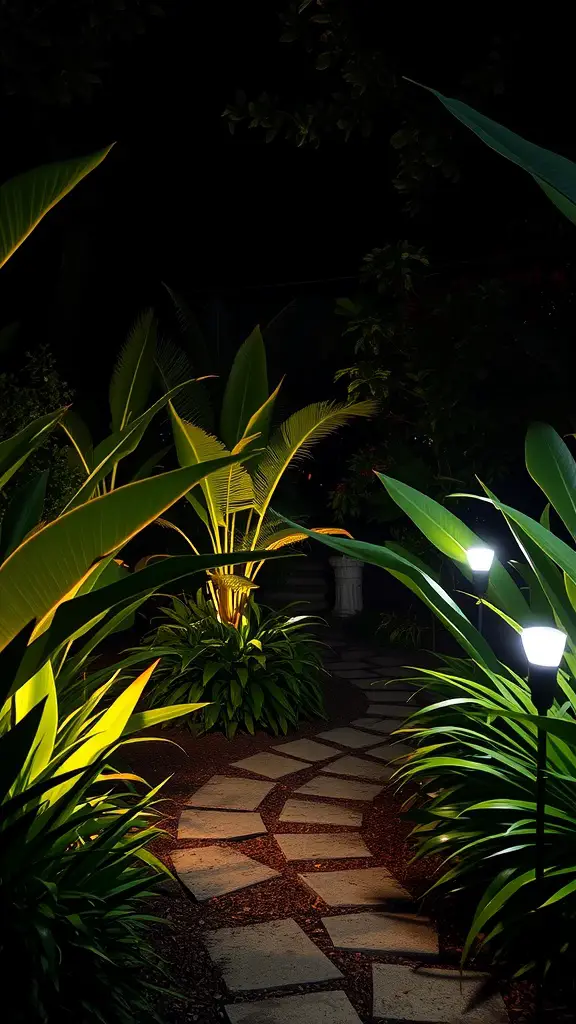
Creating a tropical garden is about more than just vibrant plants and flowers. At night, the right lighting can transform your oasis into a magical retreat. The image showcases a beautifully illuminated pathway framed by lush greenery, setting the scene for a serene nighttime stroll.
The soft glow from the lights highlights the rich textures of the leaves and stones, drawing attention to the natural beauty of the garden. This kind of lighting not only enhances visibility but also adds warmth and ambiance. Using well-placed lights along pathways can create a welcoming atmosphere, guiding your guests through the garden with ease.
Consider using a mix of uplighting and pathway lights. The uplights in the image illuminate the surrounding plants, creating shadows and depth. This technique adds dimension and makes the garden feel alive at night. Pathway lights, like those seen here, help define the walkways, ensuring safety while enhancing the overall aesthetic.
When planning your lighting, think about the mood you want to create. Soft, warm lights give a cozy feel, while cooler lights can offer a more modern touch. Experiment with different angles and intensities to find the perfect balance that suits your tropical paradise.
Creating Microclimates Within the Garden

Creating microclimates in your garden can transform a simple space into a lush tropical paradise. The image captures a vibrant scene filled with diverse plant life, from dramatic palm fronds to colorful bromeliads. The interplay of light and shadow creates different temperature zones, making it easier to grow a variety of plants.
One way to achieve microclimates is by using existing features like large trees or structures. The majestic tree in the center of the garden not only adds height but also provides shade, helping to cool the surrounding area. This allows shade-loving plants to thrive alongside those that prefer more sunlight.
Another essential aspect is the arrangement of plants. By placing larger plants like the palms strategically, you can create sheltered spots. These areas can protect smaller plants from harsh winds and direct sunlight, offering a more comfortable environment for growth.
Furthermore, consider adding stones or pathways made from natural materials, as seen in the image. These elements not only guide the eye through the garden but also absorb heat during the day. At night, they release this warmth, helping to moderate temperatures in the immediate area.
Using a variety of foliage colors and textures can enhance the visual appeal of your microclimates. The rich greens and striking reds in the image show how different plants can create a lively atmosphere. Choosing plants that complement each other will make your garden feel cohesive and inviting.
Selecting Drought-Resistant Tropical Plants

When designing a tropical garden, it’s essential to choose plants that thrive in the heat while needing less water. The image shows a beautiful arrangement of vibrant tropical plants, showcasing the lush foliage and bright flowers that can make your garden pop.
The large green leaves in the picture are not only visually appealing but also play a crucial role in conserving moisture in the soil. Plants like these can provide structure and shade, which helps other plants nearby retain water. Notice the striking red flowers peeking through the leaves? These add a splash of color and can attract pollinators, benefiting your garden’s overall ecosystem.
If you look closely, you can see a variety of textures and shapes, which is great for creating visual interest. Using plants such as agave and other succulents can help fill in dry spots, as they require minimal watering once established. This balance of drought-resistant plants with the more water-loving varieties can keep your garden looking fresh without excessive maintenance.
So, as you plan your tropical garden, consider incorporating these resilient beauties. They not only add beauty and diversity but also support a sustainable gardening approach.
Incorporating Natural Stone Elements

When designing a tropical garden, adding natural stone elements can truly enhance the overall look. The combination of lush greenery and rugged stone creates a beautiful balance that feels organic and inviting.
In the image, we see a lovely arrangement of stones nestled among vibrant plants. The rocks are varied in size and shape, which adds visual interest. This layering effect can make any garden feel more dynamic and alive.
Using stones as pathways, like the ones shown, not only provides a functional route but also complements the tropical vibe. They guide visitors through the garden while harmonizing with the natural surroundings.
Incorporating these elements can also help with drainage and soil stability. Plus, they require minimal maintenance compared to some plants. So, you can enjoy the beauty of your tropical garden without too much fuss.
Using Vertical Gardening Techniques

Vertical gardening is a fun and creative way to bring greenery into your space, especially in a tropical garden design. The image showcases a vibrant vertical garden filled with lush plants that create a stunning wall of greenery. Imagine transforming a plain wall into a lively display that not only looks great but also improves air quality.
This specific setup features various tropical plants, each chosen for their unique shapes and colors. The rich greens, combined with occasional yellow leaves, adds depth and texture. Using a vertical structure allows you to maximize space while creating a serene atmosphere that invites relaxation.
One of the key benefits of vertical gardening is its ability to fit into any area, no matter how small. You can easily install a vertical garden in your backyard, balcony, or even indoors. This flexibility makes it perfect for anyone looking to enhance their environment without the need for extensive yard space.
When selecting plants for your vertical garden, think about how they will interact with each other. Consider a mix of trailing vines and larger foliage to create visual interest. Also, pay attention to light requirements; some plants may thrive in bright light while others prefer shade. This balance is essential for maintaining a healthy, thriving garden.
To keep your vertical garden flourishing, regular maintenance is key. Watering needs will vary based on the plants you choose and the climate. It can be helpful to set up a simple irrigation system or use self-watering pots to ease your workload.
Creating a Tropical Herb Garden

If you’re dreaming of a tropical herb garden, look no further! The image showcases a vibrant collection of herbs, each ready to add flavor to your dishes. From basil to mint, these plants thrive in warm, sunny spots.
Start by choosing your favorite herbs. Basil is a popular choice, known for its sweet aroma and versatility in cooking. Mint adds a refreshing touch, perfect for teas and desserts. Consider adding cilantro and lemongrass for an extra kick in your recipes.
Plant your herbs in well-drained soil, ensuring they get plenty of sunlight. Grouping plants together can create a lush look while making maintenance easier. Don’t forget to water them regularly, as tropical herbs love moisture!
As they grow, you can enjoy the benefits of having fresh herbs on hand. Just imagine picking a few leaves to toss into your salads or sauces. It’s a delightful way to enhance your meals while enjoying the beauty of your tropical garden.
Building Cozy Nooks with Seating

Creating cozy nooks in your tropical garden is all about blending comfort with nature. As seen in the image, a simple wooden bench nestled among lush greenery offers the perfect escape. This kind of seating area invites you to sit back, unwind, and soak in the beauty around you.
The surrounding plants play a crucial role in this design. Tall palm fronds and vibrant foliage create a feeling of intimacy and privacy. This space feels like a hidden gem, encouraging you to relax with a book or enjoy a cup of coffee. Consider using soft cushions to enhance comfort, making your nook even more inviting.
Pathways, like the stone steps shown here, help guide you to these serene spots. They not only add structure but also lead your eyes deeper into the garden. You can incorporate various materials for your seating, but natural wood complements the tropical theme beautifully. Pair it with colorful plant choices to add visual interest.
Incorporating cozy nooks into your tropical garden design enriches the overall experience. It’s not just about aesthetics; it’s about creating spaces where you can enjoy moments of peace amid vibrant surroundings.
Embracing Seasonal Changes in Plant Selection

Creating a tropical garden is not just about choosing vibrant plants; it’s also about understanding how seasonal changes can affect your selection. In this image, you can see a lush landscape filled with a mix of colorful flowers and green foliage. Each plant offers a unique touch, showcasing the variety available in tropical gardening.
When selecting plants, consider their blooming seasons. Some flowers, like the bird of paradise, thrive in the summer, while others may flourish in cooler months. This variety allows your garden to display different colors throughout the year, keeping it lively and engaging.
Additionally, think about how some plants can become focal points during specific seasons. The bold hues of the pink bromeliad in the center of the image demand attention, making it an ideal choice for summer displays. Meanwhile, smaller flowering plants can pepper in bursts of color in between larger foliage, creating a layered look.
Watering and care also vary with the seasons, so it’s important to adapt your gardening practices accordingly. For example, tropical plants often require more water during their active growing seasons but may need less during dormancy. This knowledge helps maintain a healthy garden, ensuring plants thrive in every season.
In conclusion, embracing seasonal changes in plant selection can lead to a dynamic and beautiful tropical garden. By choosing a variety of plants that bloom at different times, you create a space that feels alive year-round, inviting everyone to enjoy its beauty.
Designing with Color-Themed Plantings
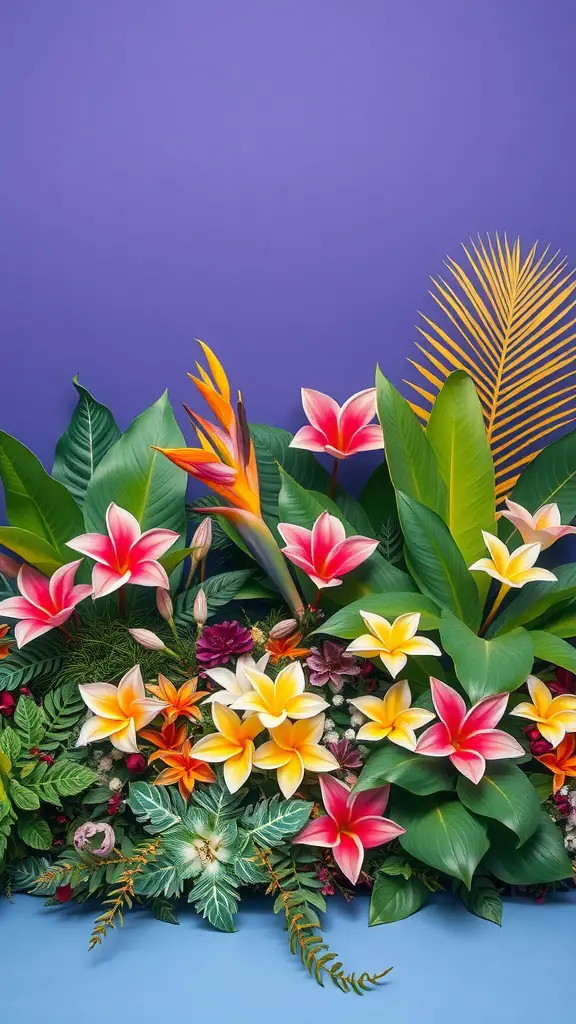
In a tropical garden, color plays a vital role in creating a lively atmosphere. The vibrant hues of flowers and foliage can transform any space into a cheerful retreat. Imagine a garden filled with colorful blossoms and lush greenery, inviting you to explore every corner.
The image shows a rich display of tropical flowers like heliconias and plumerias, bursting with color. Their yellow, pink, and orange petals create a striking contrast against the deep green leaves. This color palette not only enhances the visual appeal but also fosters a sense of calm and joy.
When planning your garden, consider using a limited color scheme to achieve harmony. Mixing complementary colors can create a stunning effect, while similar shades provide a soothing ambiance. Don’t shy away from experimenting with different textures and shades. The interplay of light and shadow will bring your tropical garden to life.
Incorporating seasonal plants can also add variety. As some flowers fade, others will bloom, ensuring your garden remains vibrant throughout the year. Try grouping plants with similar colors for a cohesive look or scattering pops of color throughout the garden for a more playful feel.
Utilizing Ground Cover Plants for Moisture Retention
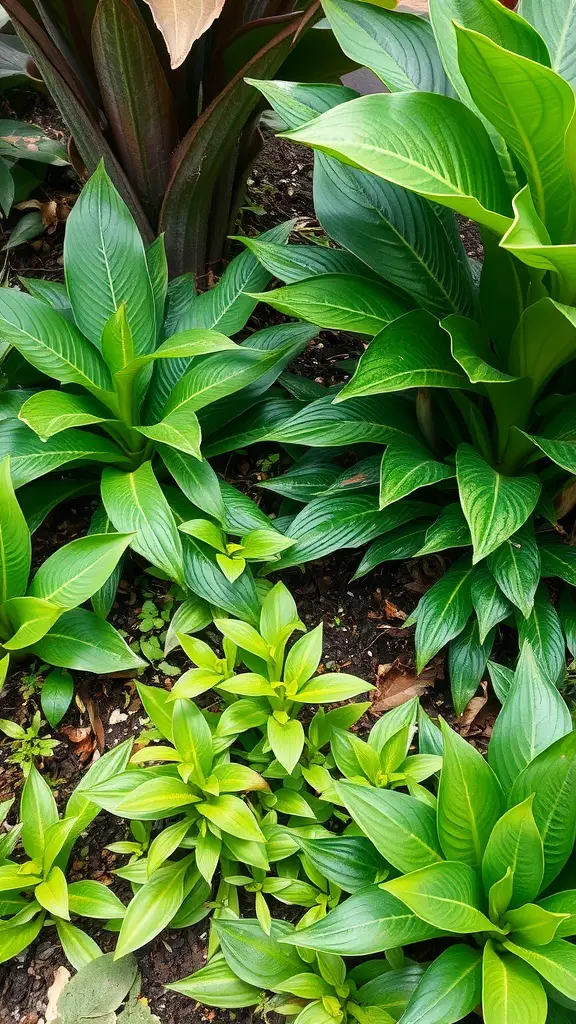
Ground cover plants play a significant role in maintaining moisture levels in a tropical garden. In the image, we see a lush arrangement of vibrant green leaves, showcasing a mix of ground covers and taller plants. These ground-hugging varieties are not just pretty; they help keep the soil damp and protect it from drying out.
When designing a tropical garden, choosing the right ground cover can make a big difference. Plants like hostas and ferns, as seen in the image, thrive in moist environments. They spread out and create a dense layer that minimizes evaporation. This means less frequent watering, which is a win for both the garden and your schedule.
Additionally, these plants contribute to the overall health of the garden. They prevent soil erosion and suppress weeds, giving your tropical oasis a clean and polished look. Plus, the diverse textures and shades of green provide visual interest, making your garden feel lush and inviting.
Incorporating ground cover plants is an easy way to enhance not just the beauty but also the sustainability of your garden. By focusing on moisture retention, you create a thriving environment where all your plants can flourish.
Harmonizing Hardscapes with Nature

Creating a tropical garden is all about blending hardscapes with natural elements. The image captures a serene pathway flanked by lush greenery, showcasing how stone and plant life can come together beautifully.
The stepping stones create a clear path, guiding the eye and feet through the garden. These stones are not just functional; they add texture and character. The contrast between the gray stone and the vibrant green ground cover emphasizes the natural beauty of the surroundings.
Notice how the tall palm trees and large leaves create a sense of enclosure, making the space feel inviting. This harmony between hard and soft elements encourages exploration while maintaining a peaceful atmosphere.
Incorporating features like steps and pathways not only helps with navigation but also enhances the overall design. It encourages movement through the garden, allowing you to appreciate different viewpoints and arrangements of plants.
Ultimately, the goal is to create a garden that feels integrated with nature. By carefully selecting materials and plants, you can achieve a space that feels both natural and well-designed, making it a joy to spend time in.
Designing Rain Gardens for Water Management

Rain gardens are a smart way to manage water while adding beauty to your tropical garden. The image showcases a lush pathway lined with vibrant green plants, guiding you through a verdant landscape. Such designs help capture rainwater, allowing it to soak into the ground rather than running off into drains.
To create a rain garden, start by selecting a location that collects rainwater naturally. The plants in your garden should be chosen based on their ability to thrive in wet conditions. Tropical plants like ferns and various palms, as seen in the image, can be perfect for these gardens.
Incorporating stone paths, like the one shown, can help direct water flow while adding an appealing aesthetic. The winding path not only invites exploration but also ensures that water is effectively managed throughout the garden.
Finally, consider the layers of your rain garden. Different plant heights can enhance drainage and create a more dynamic view. With careful planning, your rain garden will be both functional and a beautiful part of your tropical landscape.
Creating Wildlife-Friendly Spaces

Designing a tropical garden can be a fun and rewarding experience, especially when you focus on creating spaces that welcome wildlife. In the vibrant image above, you can see a lush array of plants, complemented by the flutter of butterflies. This setting not only looks beautiful but also serves as a habitat for various creatures.
Incorporating plants that attract butterflies is an excellent way to enhance your garden’s charm. The bright orange flowers and rich greenery in the image illustrate how colorful blooms can draw in these pollinators. Consider adding native plants that provide nectar and host plants for caterpillars to thrive.
It’s also important to create layers in your garden. Tall palms and broad leaves can give shelter to birds and small mammals. The dense foliage shown in the image offers a perfect hiding spot for critters seeking safety. By diversifying plant heights and types, you create a more inviting environment.
Don’t forget about water sources! A small pond or birdbath can attract a variety of wildlife. The visual appeal of water, combined with the vibrant plants, can make your garden a lively ecosystem. The vibrant activity of butterflies and other creatures can turn your garden into a lively space.
Incorporating Exotic Fruit Trees

Exotic fruit trees can bring a tropical vibe to your garden, making it feel lush and inviting. Imagine walking through your outdoor space and being greeted by the sight of vibrant fruit hanging from branches. These trees not only add beauty but also provide delicious treats.
In the image, we see trees bearing colorful fruit, likely a type of mango. The warm colors of the fruit contrast beautifully with the deep green leaves, creating a picturesque scene. Such trees can be a focal point in your garden, drawing the eye and sparking conversation.
When designing your tropical garden, think about the types of fruit trees you’d like to include. Consider how much sunlight and space each will need. Fruit trees like mangoes thrive in sunny spots, so place them where they can soak up the rays. Pair them with other tropical plants for a cohesive look.
Caring for exotic fruit trees can also be rewarding. They usually require regular watering and some pruning to keep them healthy. In return, you’ll enjoy fresh fruit right from your garden. Imagine making smoothies or desserts with your homegrown produce!
Incorporating exotic fruit trees into your design is a fun way to enhance your outdoor space. Not only do they look appealing, but they also offer tasty fruits that can elevate your culinary creations. So, why not add a splash of color and flavor to your garden with these beautiful trees?
Fostering Community Through Shared Garden Spaces

Gardens are more than just pretty landscapes; they can be vibrant community hubs. The image captures a tropical garden filled with lush greenery, inviting paths, and friendly faces. The layout encourages interaction among neighbors, promoting a sense of belonging.
In shared garden spaces like the one shown, people often come together to plant, nurture, and harvest. This creates opportunities for conversation and collaboration. As community members work side-by-side, they build connections that go beyond the garden.
Additionally, the vibrant plants serve as a backdrop for community events. Workshops on gardening, cooking, or sustainability can take place here, further strengthening bonds among participants. Whether it’s sharing gardening tips or a potluck dinner featuring fresh produce, these experiences cultivate friendships.
Having a shared garden also fosters a sense of responsibility. Everyone involved tends to the plants, ensuring the space remains beautiful and productive. This shared investment deepens connections and creates pride in the community.
Ultimately, these gardens are spaces for growth—both for plants and for the relationships that flourish within them. By nurturing the land together, communities can cultivate a spirit of cooperation and harmony.
Incorporating Art and Sculptures

In a tropical garden design, art and sculptures can add a unique touch. They create focal points and enhance the overall beauty of the space. The image showcases a graceful sculpture surrounded by lush greenery and vibrant flowers, illustrating how art can harmonize with nature.
The figure in the sculpture conveys a sense of tranquility, complementing the serene atmosphere of the garden. This balance between the organic and the artistic captures attention and invites contemplation. Using sculptures made from natural materials can also promote sustainability in your garden design.
When selecting art pieces, consider the colors and textures of your plants. The bold red flowers and rich green foliage in the scene create a lively backdrop that enhances the sculpture’s elegance. Choose pieces that resonate with your garden’s vibe, whether it’s whimsical, modern, or traditional.
Placement is key; positioning sculptures along pathways or near seating areas can create inviting spots for relaxation. This not only draws the eye but also encourages visitors to explore different areas of the garden. Incorporating thoughtful art elements can transform your tropical garden into an enchanting retreat.
Using Textured Plants for Visual Interest

When designing a tropical garden, consider the beauty of textured plants. The variety of shapes and sizes can create a lively atmosphere. For instance, large, glossy leaves add depth, while bold colors capture attention.
In this image, you can see a mixture of lush greens and vibrant oranges that pop against the backdrop of darker foliage. This contrast enhances the overall visual appeal of the garden. Textured plants like these not only provide contrast but also create layers that draw the eye.
Incorporating different plants with varied textures can help to establish focal points throughout your garden. Notice how the striking orange flowers stand out against the smooth, green leaves? This kind of layering adds richness and complexity, making your garden more inviting.
Additionally, using plants with unique leaf shapes can offer a sense of movement within the space. For instance, the long, tapered leaves catch the light in interesting ways, creating shadows and highlights that change throughout the day.
By thoughtfully selecting textured plants, you can create a tropical garden that feels vibrant and full of life. So next time you’re planning your garden, remember to mix textures for a truly engaging experience.
Incorporating Seasonal Blooms

In a tropical garden, seasonal blooms can truly transform the space. The image showcases vibrant flowers nestled among lush green foliage. With colors like bright pink and orange, these blooms draw the eye and create a lively atmosphere.
Seasonal flowers not only add color but also attract pollinators. Butterflies and bees love visiting these blooms, which can enhance the overall health of your garden. Planting a variety of flowers that bloom at different times ensures that there’s always something in bloom, keeping your garden lively year-round.
Consider mixing bold tropical flowers, like the ones in the image, with plants that have interesting textures. This combination creates depth and visual interest. For example, the large green leaves provide a perfect backdrop to make those colorful flowers pop even more!
Designing with Climate Considerations

When it comes to tropical garden design, climate considerations are key. The image shows two people discussing plans in a lush setting, surrounded by vibrant greenery. This environment is ideal for nurturing a variety of tropical plants, which thrive in warm, humid conditions.
Using climate data helps in making informed decisions about plant selection. For instance, the chart in the image indicates growth patterns that can guide which plants will flourish in your garden. Understanding local weather patterns can help you choose the right species that will not only survive but also thrive.
It’s also crucial to think about water management in tropical designs. Plants often require more water in hot climates. Implementing sustainable practices like rainwater harvesting can make a big difference. This approach not only supports the garden but also conserves resources.
Lastly, consider how the layout of your garden can influence temperature and humidity levels. Strategic placement of larger plants can provide shade and create a microclimate that benefits smaller plants. Observing how light and shade play out throughout the day is invaluable in this planning stage.
Integrating Tidal and Coastal Elements

When designing a tropical garden, think about how to bring in those tidal and coastal vibes. The image shows a lush green environment with a serene water feature, perfectly reflecting this idea. It’s all about creating a harmonious blend of plants and water.
The large, vibrant leaves and tropical palms are ideal for setting that coastal scene. They not only add beauty but also create a sense of shade and comfort. Incorporating smooth stones and water elements adds a natural touch, mimicking the shoreline.
Floating stone paths across the water invite exploration, making the space feel more interactive and engaging. This design encourages you to wander and appreciate the unique features of your garden. Adding coastal decor, like small driftwood or seashells, can enhance the theme even more.
By combining these elements, you’ll create a tropical oasis that feels refreshing and inviting. It’s a great way to enjoy nature while lounging in your backyard, offering a peaceful retreat right at home.
Encouraging Sustainability with Native Plants

In this lush tropical garden, the vibrant greens and varied textures tell a story of natural beauty and sustainable practices. Native plants make up a significant portion of this design, providing habitat for local wildlife and reducing the need for chemical fertilizers and pesticides.
The winding stone path highlights how easily you can create a serene walkable space while encouraging biodiversity. Native plants are low-maintenance and well-suited to the local climate, which means less watering and a more sustainable garden overall.
Incorporating a mix of palms and broad-leaved plants not only enhances the visual appeal but also supports local pollinators, like bees and butterflies. This garden creates an inviting atmosphere while promoting a healthy ecosystem, making it a perfect example of how to design with sustainability in mind.
Creating a Zen Tropical Retreat
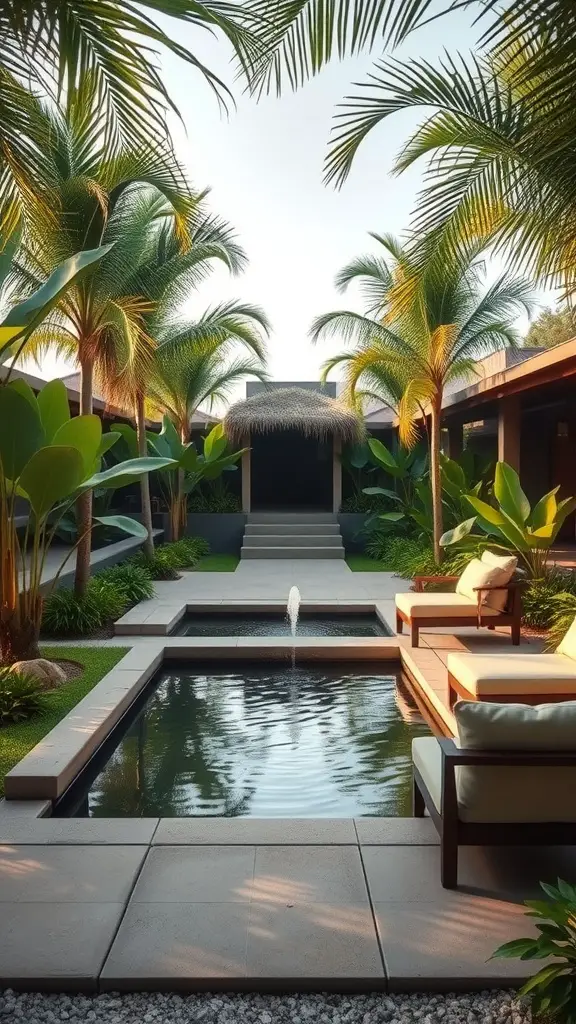
Imagine stepping into a serene oasis, surrounded by lush greenery and tranquil water features. This tropical garden design invites relaxation and mindfulness. The palm trees sway gently in the breeze, and their vibrant fronds add a splash of color against the clear sky.
The centerpiece of this retreat is a peaceful water feature. The gentle sound of water bubbling from the fountain creates a calming atmosphere. It’s a perfect spot for meditation or simply unwinding after a long day.
In addition to the water, the choice of seating is key. Comfortable lounge chairs beckon you to sit back and enjoy the beauty around you. This outdoor space seamlessly blends natural elements with modern design, making it an ideal escape.
Surrounding the seating area, carefully chosen plants enhance the tropical vibe. Large leaves and vibrant greens contribute to the lush environment, offering a feast for the eyes. You can almost feel the tranquility that this garden exudes.

